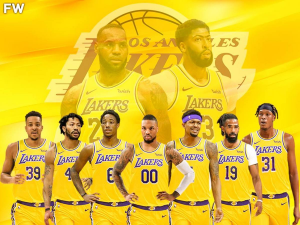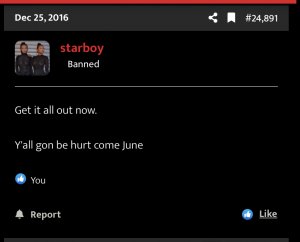By Kelly Iko 5h ago
6
Hawks forward John Collins threw down another emphatic alley-oop with 4:53 left in the first quarter of Atlanta’s March 16 game against the Rockets and head coach Stephen Silas jumped up to call timeout, desperate to slow down Atlanta’s 7-0 run. A dejected
Kevin Porter Jr., the turnover culprit, walked slowly towards the bench with his head down.
It was only his fourth game with the team, having just returned from the G-League bubble, hardly enough time to make a mark. But Porter was particularly down on himself. Judging from his body language — or Houston’s current form — you would have assumed that the Rockets were down by double digits already and not just the four points they actually trailed by.
While the rest of his teammates convened around Silas for in-game instructions, Porter stood off to the side for a bit, his head still down. Eventually, he made his way over to the bench to join the rest.
Perhaps in the past, during his rookie year in Cleveland, things would have gone differently. There might have been arguments and disagreements, older veterans getting on the young guy for trying to do too much.
That isn’t how it’s been since Houston traded for the 20-year-old in January. As soon as he sat down, the encouraging conversations began. There were no fingers pointed, no back-and-forths. Porter described what he was seeing on the floor and what he was trying to do. He had attempted to hit a cutting Jae’Sean Tate with a difficult bounce pass, but there was a much easier option in an open Sterling Brown on the wing. Lead assistant John Lucas walked over and stood right next to Porter as Silas continued to strategize, providing an encouraging presence.
On Houston’s next possession following the timeout, Porter was faced with a similar scenario. The defense cheated and slid towards him, meaning that Brown was once again open on the wing. This time, Porter made no mistake. He swung it to Brown, who nailed the triple.
Before the end of the quarter,
John Wall called Porter over during another timeout. Wall wasn’t playing that night due to injury, but he was still paying close attention to what was happening on the floor. Using his hands, he demonstrated a game situation, what Porter did and how he could have approached it differently.
Christian Wood, who also wasn’t playing, joined in on the conversation holding the box score as they looked it over. But this wasn’t just another teaching moment between a master and his understudy. It was another visual of the support system that Porter has in his new home. A loving bond of brothers who want the best for him and want to see him succeed, because it helps them as well.
A young player could hardly ask for anything more.
“I think it’s been good,” Silas said of the Porter Jr’s early days in Houston. “We’ve been in constant communication. He’s done everything that we need him to do. The situation of him going to the G-League bubble helped. He really knows that we care about him. We care about him as a basketball player, but a person as well. It’s a daily process — trust isn’t built in just a day or week. It’s built day after day, week after week, month after month. It seems like it’s going in a pretty good direction. We have a lot of trust in him. There’s going to be ups and downs and conversations to be had just like every other player, but my door is always open and there’s a support system that can help him be successful on and off the floor.”
And right now, just 10 games into his Rockets tenure, success is coming to Porter Jr.’s side faster than anyone envisioned.
Rockets GM Rafael Stone was just as surprised as anyone at how
Porter’s time in Cleveland had ended, but once the opportunity to acquire the former first-rounder came knocking, Stone’s aggressive, talent-seeking nature took over.
“As soon as I became aware, I called,” Stone told
The Athletic. “But I didn’t call to make an offer. I called to find out what was going on. Cleveland gave us permission, and Stephen, myself and John all separately talked to him before we did the deal — and those conversations were very important. I got the sense that he was the type of guy that I wanted to work with and thought giving him an opportunity made sense. The other guys thought the same.”
Stone came away from his conversation with the Cavaliers convinced that Houston could be the right place for a fresh start. Off the court, Lucas’ presence bodes well for players who need guidance, tough love and support. On it, Porter Jr. would be another talented skill player for Silas, the first-year, offensive-minded head coach, to mold.
It also helped that Stone was already quite familiar with Porter’s game. Both are from the Pacific Northwest, and Stone had gotten the chance to watch Porter Jr. when he came up in the ranks in Seattle as a five-star recruit in high school. There was a great deal of untapped potential, something Stone knew before ever speaking with Cleveland. It had been a little over a week since he had sent James Harden to Brooklyn in a blockbuster deal, but he had a plan: to bring Porter in and to change his position from shooting guard to full-time point. The comparisons between Porter and Harden weren’t new — two left-handed scoring guards with a nice handle and an overall unique skill set — but Harden’s career arc changed the minute the ball was put in his hands consistently. Stone was confident that Porter’s strengths more than warranted a similar change.
“For me, his best two skills are ball-handling and passing — that sounds like a point guard,” Stone said. “I wanted to put him in a position to maximize his current talent. He can get better at everything, he’s 20 years old, but it’s pretty evident when you watch him play that his ball-handling and passing are exceptional. He’s able to do things with the ball and see things on the court that a lot of guys don’t see and do. Playing on the ball is the way to maximize those two skills.”
After trading for Porter,
the path to point guard was in motion. The front office sent him down to play with the Rio Grande Vipers, the team’s G-League affiliate, in the bubble. It was a move that was designed to kill two birds with one stone. Because Porter wasn’t in game shape, he could use these games to work his way into playing form. At the same time, he would be able to learn the ropes of a full-time lead guard — and all of the responsibilities that come with it. The Vipers ran a similar system to Houston’s, so Porter could immerse himself in Silas sets and philosophies. His stint with the Vipers ended at the end of their regular season, but it was largely successful. Porter dished out 7.2 assists per game, tops in the league, to go along with 24.1 points, 6.5 rebounds and 1.5 steals.
Bubble Ball
PLAY TYPE
| % TIME
| PPP
| %ILE
|
|---|
| P&R Ball Handler | 34.5 | 0.82 | 74th |
| Isolation | 21 | 0.93 | 69th |
| Transition | 19.9 | 1.01 | 51st |
Sure, Porter excelled in the bubble, but would that necessarily translate back to the NBA?
“You don’t know whether it’s gonna transfer, right?” Silas said last week. “But he isn’t just a scorer. He makes plays for others, he puts pressure on the defense and he has a pace about him that is kind of hard to guard.”
Short chart via Cleaning The Glass
10 games into his Rockets career, all of that has shined through. His outside shooting has struggled (.218 on 6.1 attempts per game), but Porter is still averaging a healthy 15.4 points and
a shade under six assists per game over his first seven starts. He scored 20 or more points only four times as a Cavalier but has already done it five times this season. His shot profile is diverse but consistent at the same time, demonstrating an ability to score at all three levels with confidence. His overall offensive profile looks average on a leaguewide scale, but his skills have certainly carried over from bubble to now — the jump in competition from the G League to the NBA warrants some context with the percentages. One thing Porter has likely already learned — concerning his isolation efficiency — is that it’s a vastly different experience going one-on-one with the best basketball players in the world.
Primetime Porter
PLAY TYPE
| % TIME
| POSSESSIONS
| PPP
| %ILE
|
|---|
| P&R Ball Handler | 39.6 | 74 | 0.81 | 37th |
| Transition | 18.2 | 34 | 1.059 | 38th |
| Isolation | 15 | 28 | 0.607 | 15th |
| Hand-Off | 8.6 | 16 | 1.062 | 74th |
| Spot Up | 9.1 | 17 | 0.824 | 19th |
Porter is in Houston to play and develop, but more importantly, he’s there to learn. He’ll be given a good amount of playing time between now and the end of the season — one of
the underlying factors in trading Victor Oladipo — but class is in session whether or not he’s on the court.
“He’s been great,” Silas said. “He’s a good listener, he’s a good learner, he asks good questions. He’s super smart and picks things up quickly. Integrating himself into the group and learning what we’re doing.”
“That’s always been a key factor when I’m on the bench” Porter added. “Paying attention to the game and the flow so you know what’s going on when you come in. I’m still learning — it’s a new offensive set, new adjustments, new teammates, new brotherhood and family.”
One of the biggest adjustments is playing with Wall in the starting lineup. Originally, the plan was to stagger Wall and Porter so that Houston had a capable ball-handler on the floor for the majority of the game, much like the success of seasons past with Harden playing alongside Chris Paul or Russell Westbrook. But it soon became clear that, whether due to him not asserting himself or not finding the right chemistry, Porter wasn’t impacting the game as anticipated with the second unit. He was better served to start from the outset.
The pairing of Wall and Porter, if you were to find the best
potential comparison, would be that of Paul and Harden lite. Not from a skill standpoint — Harden is eons ahead of Porter — but Paul and Wall are natural playmakers, and the hope is Porter ascends to genuine stardom alongside the veteran. Wall dealing with a knee effusion has limited the duo to only 55 minutes together thus far, but the two are in constant communication.
“John’s easy to play with,” Porter said. “He’s very vocal, so honestly, I learn a lot just being out there with him. Even when I come to the bench he stays vocal. He tells us what he sees and we do the same. We just gotta keep staying connected.”
The beauty of Silas’ offense is that it’s not some uber-complicated collection of X’s and O’s. Kelly Olynyk gave some insight last week about why he’s been able to fit in so quickly, noting that Silas plays a free-flowing system based on principles and simple sets. For a young player like Porter learning the ropes, that is beneficial.
Houston often runs actions like this starting with two players stationed in either corner with Wall bringing the ball up the middle of the floor calling out the play. Wall waits for Olynyk to a pin down for Porter to curl around before firing a pass to Porter. Now all Porter has to do is run a side pick-and-roll with Olynyk, and he has options on his plate. He can take the open mid-range, he can find Wall back at the opposite wing or he can find a trailer making a 45 cut. Tate darts behind the defense that is fixated on Porter and has a layup opportunity. The shot is blocked, but the process worked (Tate’s extra steps also allowed the defense to recover some). All it took was Wall setting the team up and putting Porter in a position to attack.
“John can do a lot of things on or off the ball,” Silas said. “He’s comfortable wherever he is. He wanted to make sure the young kid was comfortable as well.”
“That’s what [John and I] always talk about off the court, playing off each other,” Porter added. “The spots we like and running the team together. We’ve been working on that and been adjusting to being on the court at the same time. I used to come in for him, but now I’m starting out there at the same time. It’s a growth process that we’re going to take together.”
Without knowing how Wall’s knee will hold up until the end of the season, it’s arguably just as important to see how Porter meshes with the team’s other offensive focal points. Take Christian Wood, for instance. As is the case with Porter and Wall, the duo just hasn’t played that long together (47 minutes), but the halfcourt benefits a versatile big man can have on a young guard are obvious. Houston’s loss to Harden and the Nets on Wednesday was an eye-opener for the duo, both for their potential as well as the work they must do to sharpen their on-court relationship.
“We’re still figuring each other out,” Wood said following Houston’s 120-108 loss. “There are times where he hits me on rolls, lobs and slips. But me and him have to do a better job in terms of when guys switch screens and I’m posting up or he’s attacking a big. It’s something we can work out. We’re both still young and learning, so we have enough time.”
Concerning the screen switching, Wood is likely referring to two specific plays. It’s important that Porter and Wood nail their chemistry down because a ton of teams will opt to switch that pick-and-roll action (and possibly throw some drop if Porter’s shot doesn’t come along).
The first is a simple setup against a Nets defense that started switching. Porter’s handle has enough gravity to freeze the defense with one crossover, which provides time for Wood to establish himself in the post against the smaller Tyler Johnson. A simple lob is enough to gift Wood an easy scoring opportunity.
There are a few things going on with this next play:
- Danuel House had started the game on fire, scoring all nine of Houston’s points and already hitting a pair of triples, so Silas opted to use him and Wood in their double-drag action. House pops, and Wood rolls hard to the rim.
- The Rockets are banking on Brooklyn switching this quick action — and the Nets do.
- Porter should make this pass ahead to Wood every time. It’s guaranteed two points.
- Go back and watch the clip again. Porter now has the mismatch with DeAndre Jordan attempting to defend him in space. It will not end well. Look at Porter’s deceleration at eight seconds. You sure there’s not an invisible “1” next to that 3 on the back of that jersey?
There will come a time in Porter’s development when making that pass will be second nature. But if you’re wondering why he doesn’t always make that read, it’s because he can do stuff like this. Per Cleaning the Glass, Porter is in the 93rd percentile on two-point percentage and shooting a ridiculous 71 percent on drives. He’s in the 88th percentile in that respect, yet drives only make up 27 percent of his offense. He should drive all day if his confidence is at a 10 like this. This is a seven-footer with a 7’3 wingspan who is in blockable range. That’s Ford Tough.
Porter averages 3.0 turnovers a game, a mark you’d like to see come down. Watching a lot of his cough-ups, his handle gets him in trouble sometimes. He’s so good at it that he tends to overdo things when a simple drive would suffice. He can be so effective leveraging his ball-handling like this play against Memphis. Desmond Bane tries to jump this screen and stick to Porter, who only needs one dribble to render that attempt useless. D.J. Wilson, a pretty good slipper, can just turn and go, and Porter makes the release pass.
Porter could have stepped back and taken the 3. Perhaps earlier in his career, he would have.
But he didn’t, instead firing the ball to where only his teammate could get it. The explanation why said everything about his investment in his newest basketball journey.
“That’s just becoming a point guard,” Porter said. “Becoming the head of the snake. You gotta get your guys in spots and see every read.”








































